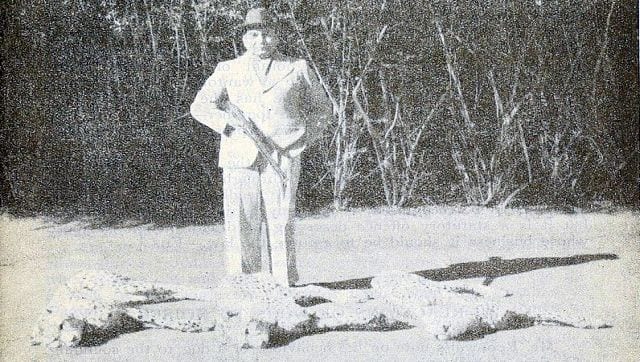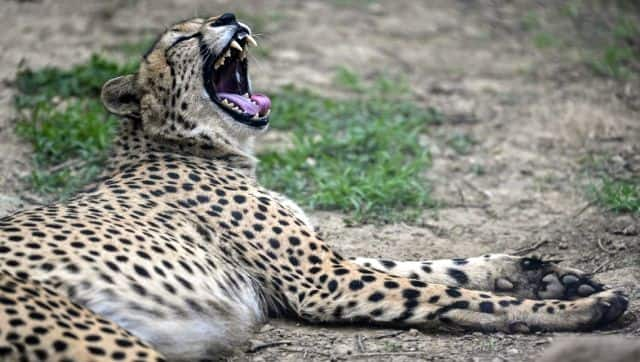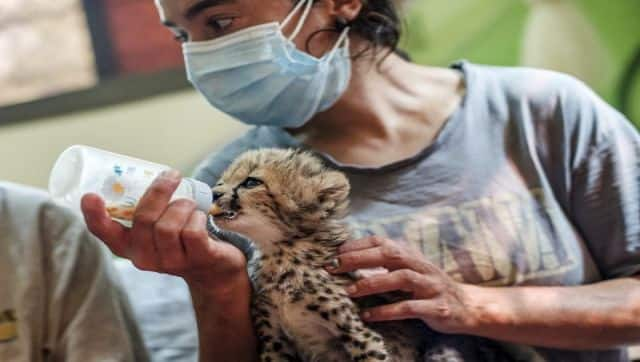In 1947, Maharaja Ramanuj Pratap Singh Deo of Koriya, Surguja, in what is today known as Chhattisgarh, shot dead the last three recorded Asiatic cheetahs in India. With that, the Asiatic Cheetah was declared extinct in India in 1952. However, on 17 September — 74 years later — eight cheetahs arrived from Namibia as part of the Centre’s elaborate plan to introduce the wild cats back into the country. We take a look at how this majestic creature, which roamed India years ago went extinct and how the country reintroduced the species and what may be the problems it faces. Cheetahs in India The first cheetah in the world to be bred in captivity was in India during the rule of the Mughal emperor Jahangir in the 16th century. His father, Akbar, recorded there were 10,000 cheetahs during his time, including 1,000 of them in his court. A BBC report states that between 1799 and 1968, there were at least 230 cheetahs in the wild in India. There isn’t any definitive answer to why the cheetah, the fastest land animal in the world, went extinct in India, but most experts attribute this to extensive hunting and habitat loss. [caption id=“attachment_10265901” align=“alignnone” width=“640”]  Maharaja Ramanuj Pratap Singh Deo of Koriya, Surguja shot three of the last cheetahs in India in 1948. Image Courtesy: Bombay Natural History Society.[/caption] In those days, the animal — found in the entire country, barring the high mountains — was hunted for bounty and sport. Reports say that a large number of cheetahs were eliminated during the British rule, as the wild cats would enter villages and kill livestock. Some attribute the extinction to desertification (the process of fertile land turning into a desert), which may have taken away the animal’s natural habitat. Plan to reintroduce cheetahs In the 1970s, Indira Gandhi was very keen on bringing back the cheetah and the Department of Environment formally wrote to the Iranian government to request Asiatic cheetahs in use for reintroduction and apparently received a positive response. Unfortunately, those talks were stalled as an Emergency was soon declared in the nation and the Shah of Iran fell from power. In 2009, the issue was rekindled and it was decided that the African cheetah would be used for introduction to India. The issue got further impetus in September of the same year when the Ministry of Environment & Forests, through the Wildlife Institute of India (WII), organised a meeting in Gajner, Rajasthan, to discuss the issue. The meeting was jointly organised by the WII in association with the Wildlife Trust of India (WTI), a prominent NGO based in Delhi. The Cheetah Conservation Fund, International Union for Conservation of Nature and other NGOs were represented as were high-ranking officials of several state forest departments. [caption id=“attachment_10265941” align=“alignnone” width=“640”]  Efforts to reintroduce cheetahs into India have been on since 2009. AFP[/caption] Ten sites in five central states were surveyed and Kuno National Park in Madhya Pradesh, which is spread across 261 square kilometres and has a healthy population of chital, sambar, nilgai, wild pig, chinkara and cattle emerged as one of the most promising habitat for the cheetah. Taking the issue forward, Union Environment Minister Bhupender Yadav on 6 January 2022 launched the action plan saying, “The cheetah that became extinct in independent India, is all set to return.”
The cheetah that became extinct in independent India, is all set to return.
— Bhupender Yadav (@byadavbjp) January 5, 2022
Launched an action plan for reintroduction of cheetah in India at the 19th meeting of the National Tiger Conservation Authority. pic.twitter.com/Gs5k0ktMUb
Interestingly, this is the first time in the world that a large carnivore was relocated from one continent to another. The cheetah was expected to be reintroduced into the country in November 2021 in Madhya Pradesh but the plan got derailed due to the COVID-19 pandemic. As per plans, the cheetahs were transported by air to India and by helicopters to the Kuno Wildlife Sanctuary . They were anaesthetised prior to transport, and radio collars were placed on them so that once they were released in India, they were already attached in case of escape or long-distance movement. The animals will be fed on natural prey while in the holding compound. Concerns over reintroduction The reintroduction of animals is not an easy task and comes with many risks. However, it is not rare either. In 2017, four cheetahs were reintroduced in Malawi, where the cat became extinct in the late 1980s. Some experts are wary about the process; according to a report in The Conversation, some experts have noted that the cheetah is a wide-ranging species, known to travel across areas up to 1,000 sq km in a single year. Indian parks tend to be much smaller than those in Africa, offering less chance for such free movement. Moreover, the report states that Kuno might not be a favourable spot as there is no data that shows that cheetahs, lions, tigers and leopards can coexist comfortably in the same habitat. It has never occurred anywhere else before, so there is no real-life experience to draw upon. [caption id=“attachment_10265961” align=“alignnone” width=“640”]  The reintroduction of cheetahs is not an easy task and comes with many risks. AFP[/caption] Wildlife expert Shubhobroto Ghosh, writing for World Animal Protection, also stated that African Cheetahs are substantively different from Asiatic Cheetahs that were found in India before they went extinct. He adds that the attention to the new cheetahs may take away resources from wildlife protection efforts that are already struggling to protect endangered animals. This means that monitoring the reintroduced animals is going to be both cost and time-intensive. But, there are others who also believe that there are huge positive dividends if the process is successful. For instance, MK Ranjitsinh, the former director of Wildlife Preservation, in an IndiaSpend interview was quoted as saying, “In the process of getting cheetahs, if we assess our grasslands and work on them to make them suitable for the introduction, we will have already achieved a lot. We also need to focus on grassland-forest mosaics. Cheetahs can survive in both grasslands and grassland-forest mosaics.” Dr Laurie Marker, the founder of Cheetah Conservation Fund — a global leader in research and conservation of cheetahs — in an interview to National Herald had said that ‘it would be exciting to think of India as having cheetahs again’. “To save cheetahs from extinction, we need to create more permanent places for them on Earth. India has areas of grassland and forest habitat, which may still be appropriate for this species. The government has a progressive mindset, and they are open to exploring the concept of introducing cheetahs to encourage healthy biodiversity. They are looking at the big picture, considering the large landscape approach. We think they are setting a marvellous precedent with the decision of translocation of the species,” she was quoted as saying. Cheetahs in the world and their dwindling population According to the World Wildlife Fund, there are estimated to be only 7,100 cheetahs left in the wild – and their future remains uncertain. The cheetah is considered vulnerable under the International Union for Conservation of Nature’s (IUCN) red list of threatened species. Please see: Saving cheetahs from going extinct, one cub at a time They are found primarily in the eastern and southern ranges of Africa, south of the Sahara Desert. Small populations are also found in North Africa and Iran. As of 2015, more than 3,500 cheetahs live in Namibia. While we can’t say if the government’s plan of reintroducing cheetahs will work, we can say that we can’t wait to hear the growl of the cheetah in India again. With inputs from agencies Read all the Latest News , Trending News , Cricket News , Bollywood News , India News and Entertainment News here. Follow us on Facebook, Twitter and Instagram.


)

)
)
)
)
)
)
)
)



